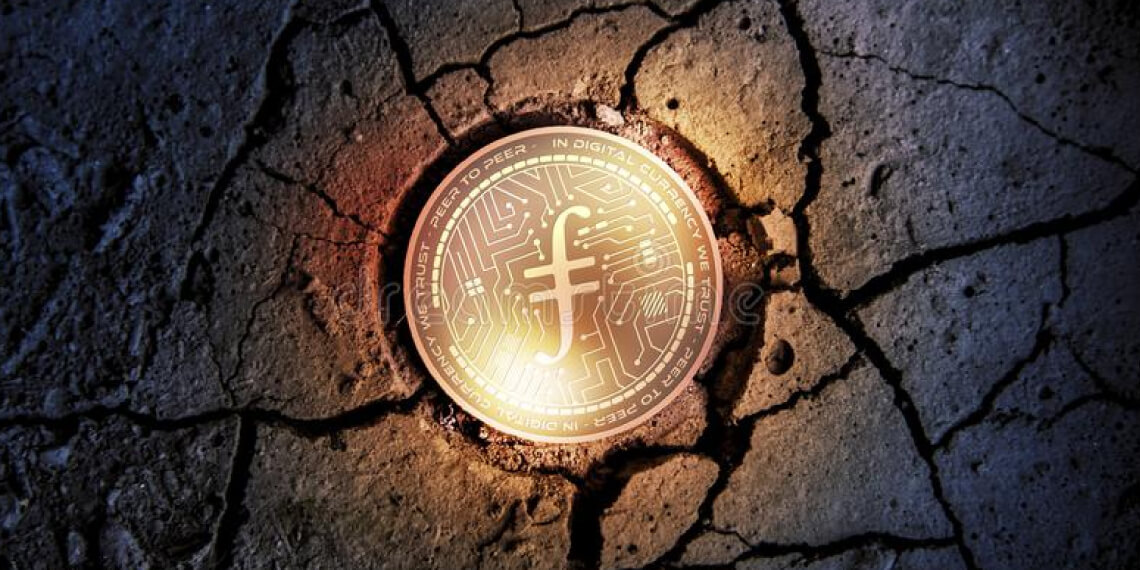Cryptocurrency mining may be conceptualized simply as a method of producing new virtual coins. But that’s where the simplicity ends. You’ll need to work out challenging riddles, verify cryptocurrency transactions on a blockchain network, and add the transactions to a distributed ledger in order to find those coins. Additional security precautions are implemented since digital platforms are simple to manipulate. For instance, only confirmed miners can update transactions on the Bitcoin ledger, helping to avoid double-spending. Since distributed ledgers are decentralized, mining is essential for verifying transactions.
Interesting in earning some reward from crypto mining? This guide provides you with information on how to mine Filecoin. Let’s get into the details.
Today’s Filecoin price is $8.10 USD, with a 24-hour trading volume of $333,710,264. Filecoin is down 6.00% in the last 24 hours. The current CoinMarketCap ranking is #33, with a live market cap of $2,111,436,344 USD. It has a circulating supply of 260,580,522 FIL coins, and the max. supply is not available.
Also Read:
- How to Buy Filecoin in 4 Easy Steps
- How to Buy Filecoin in 4 Easy Steps
- Filecoin Price Prediction 2022-2031: What’s the future for FIL?
- Filecoin price analysis: FIL rallies to $7.35, gaining 23 percent overnight
What is Filecoin?
In order to optimize data storage and retrieval, Filecoin was developed as an open-source, cloud-based decentralized storage network (DSN). The Filecoin network uses a mining, storage, and retrieval system that links clients who pay to store and retrieve data with storage miners (providers) and retrieval miners (servers). In exchange for performing services on the network, network users get and transmit Filecoin tokens (FIL), which are tokenized incentives.
The Filecoin system uses specific cryptographic proofs to validate the numbers and types of files on the network in order to carry out this data exchange and make the network open and fair for all users. This is intended to provide protection against unintentional file modification.
In recent years, a number of difficulties experienced by cloud-based storage providers have come to light more and more. The native token of the Filecoin network, which has a market capitalization ranking of #18 right now, is called FIL. The incentive that Filecoin network users pay for the miners to keep their data is how we’ve progressed FIL. Their files will have additional degrees of security the more they spend.
Therefore, FIL is the compensation miners receive for their contributions to the community. The project raised $205 million in an ICO in 2017; however, Filecoin’s mainnet debut was put off until block 148,888, which happened in the middle of October 2020.
How Filecoin Mining works
Filecoin miners compete with one another to mine and build blocks, just like Bitcoin miners do. In contrast to Bitcoin, the amount of active storage is directly connected with the mining power of Filecoin. The system is designed to provide miners with a financial incentive to amass as much storage space as they can in order to rent it out to clients. The Filecoin protocol directly connects data storage and retrieval to the system’s mining mechanism.
Three categories of FIL miners may be distinguished (although one group has not yet entered service):
Storage Miners
These Filecoin miners store customer data as storage providers. The amount of storage they produce directly relates to how much money they make. This also requires large storage data.
Retrieval Miners
Servers (also known as retrieval miners) acquire Filecoin by charging a fee for their services. Their pay is based on how quickly and nearby they can provide service.
Repair Miners
Repair miners are yet to be used in Filecoin mining, but their purpose is to step in when an unstable miner is present.
Once a contract is made with a customer, storage providers or storage miners save the proof of the data storage. Anyone may check the proof and determine the miner’s reliability.
On the other hand, retrieval miners or servers deliver client data (from customers or storage miners) when needed.
Requirements for Filecoin Mining
You will need the following before you can start mining:
A Powerful CPU
A machine having a virtualization-capable CPU with more than 8 cores, such as an AMD EPYC, Intel Xeon Scalable, or IBM Power9 processor. Contributing computational power makes mining Filecoin more profitable.
Large Disc Space
1 TiB minimum of NVMe-based disc space is required for cache storage. Additionally, we advise purchasing a second hard disc for the purpose of storing data. You may earn more Filecoin if you have more space to store data. The network parameters total more than 100 GiB. Having more storage space makes mining Filecoin profitable.
Powerful RAM
RAM of at least 128GB (along with 256 GiB of swap).
Efficient Internet Connection
An effective Internet connection.
A Filecoin Wallet
A wallet for Filecoin. Your Filecoin will be kept at this place. Either the official Trust Wallet app or an internet platform like Coinbase can be used to build one.
Wallets to Store Filecoin
The Ledger Nano and Lotus are the two most often used wallets that support Filecoin. These will provide you with a high level of protection, and you can always access your cryptocurrency holdings wherever you are.
How to Mine Filecoin
The mining process used by Filecoin is distinct from the conventional mining process used by Bitcoin and other cryptocurrencies.
The Filecoin network uses the Proof-of-Replication (PoRep) and Proof-of-Spacetime (PoST) consensus algorithms.
Instead of providing computing power for Filecoin, miners provide storage space to meet users’ and consumers’ demands for data storage.
Each Filecoin miner has a power value assigned by the network that is inversely correlated to the quantity of space provided. This value influences the chance of obtaining the right to mine a block in each epoch.
The Filecoin network offers many incentives to miners in exchange for their labor.
Filecoin Mining Markets
- File storage;
- File retrieval;
- Token exchange.
Customers frequently have to pay storage fees as a cost in exchange for the storage of their data and the miners’ regular transmission of storage proofs to the blockchain after an agreement has been reached.
Filecoin Mining Rewards
Transaction costs are another name for storage fees. Upon reception, these transaction fees are momentarily kept before being instantly transferred into a miner’s wallet if the necessary conditions have been satisfied.
Proof-of-Spacetime (PoST) window checks, often known as network-wide one-day intervals, are performed to ensure that miners are continuing to host their required sectors as needed.
The procedure that must be undertaken in order to be given permission to mine a new block is known as winning PoST.
In contrast to storage fees, the customer does not cover these incentives. Instead, as an inflationary process and an incentive for miners to advance up the chain, the network “prints” more FIL tokens.
Consumers, on the other hand, are responsible for storage expenses.
In addition to the block reward that each miner receives, they have the possibility to collect transaction fees connected to each message that is contained in the block.
Storage miners may also compete for exclusive deals from trusted customers, which demand that the miner guarantee large volumes of data storage in order to be eligible for the deal. This is being done to encourage data storage.
As the recovery agreements are successfully finished, the recovery fees are gradually paid through the payment channels. If miners cannot keep the sector’s dependability or want to quit the network willingly, they must pay these fines.
Advantages of Mining Filecoin
Making money out of bitcoin mining is the apparent advantage. The financial gain might be significant in various circumstances. However, Proof-of-Stake mining seeks to minimize environmental damage and could eventually assist in reducing that disadvantage.
Drawbacks of Mining Filecoin
High Operating Cost
The primary disadvantage is that mining cryptocurrency also costs a lot of money, both in terms of the hardware you need to buy and the power needed to do it.
Additionally, you could find that during the time you were mining, the cryptocurrency’s value dropped due to the market’s instability.
Not Eco-friendly
The effect on the environment is another negative. According to The New York Times, the creation of one Bitcoin requires 91 terawatt-hours of power annually, which is more than Finland’s 5.5 million-person population uses.
Conclusion
Even though the Filecoin mining method requires effort, a good computer makes it possible. Simply adhere to the instructions we provided, and you’ll soon be on your way to receiving Filecoin rewards. This is a friendly suggestion but not a piece of investment advice. Please do your own due diligence and invest time while not risking time for your basic necessities.
[the_ad_placement id=”writers”]





